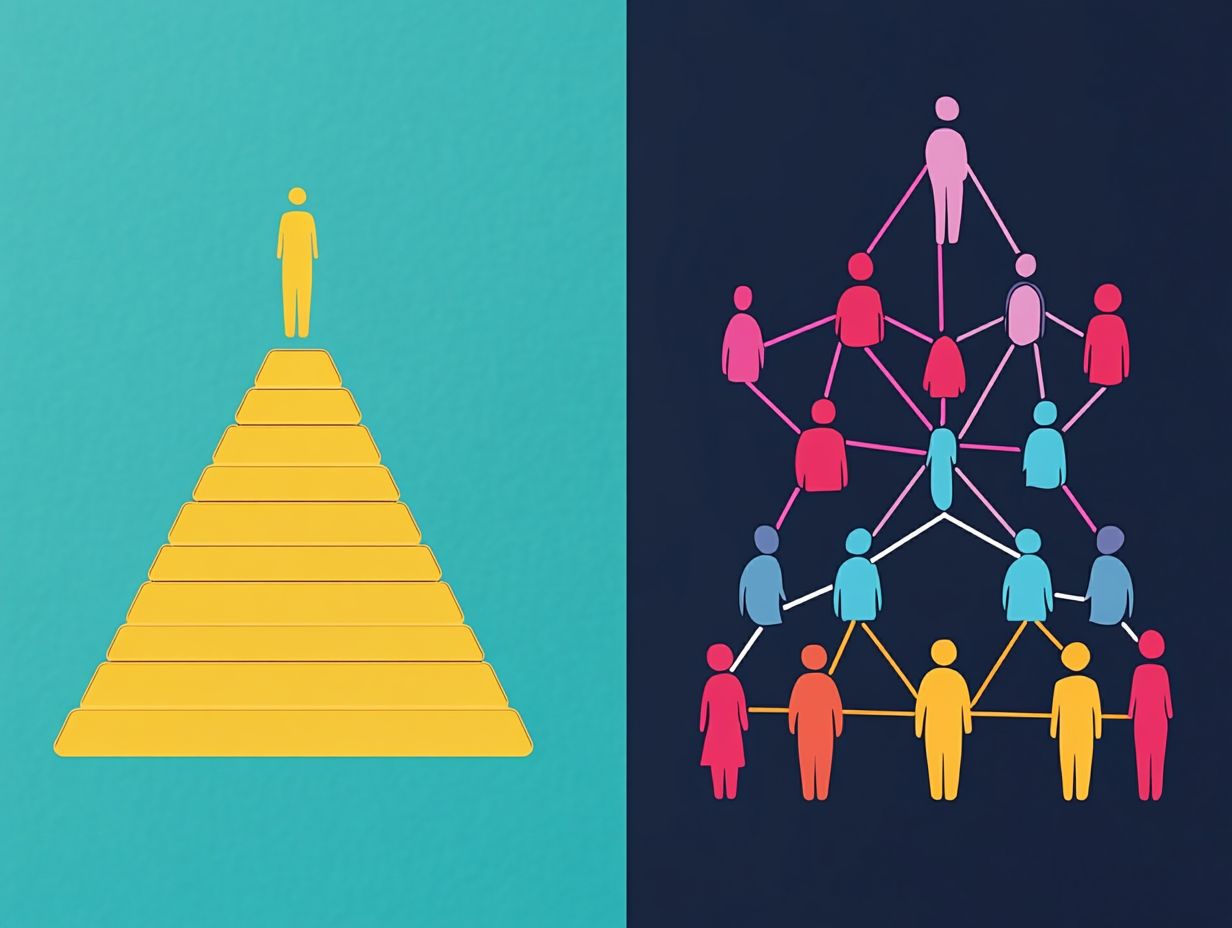Navigating the intricate realm of multi-level marketing (MLM) presents its challenges, particularly with the pressing question: Is it a legitimate business model or merely a veiled pyramid scheme engaging in high-pressure tactics?
This article elucidates the essential distinctions between MLMs and pyramid schemes, enabling readers to identify the red flags indicative of dubious practices and illegal scams.
By providing insights into compensation structures, product emphasis, and legal standings, individuals will be better prepared to make informed decisions, thereby safeguarding themselves against potential pitfalls within the MLM landscape, including investment risk.
Key Takeaways:

Understanding Multi-Level Marketing (MLM)
Insights from experts like Susan Ward from The Balance and David Rubin highlight the nuances of MLMs.
Multi-Level Marketing (MLM), often referred to as network marketing, represents a sophisticated business model in which individuals accrue commissions not solely from their own product sales but also from the sales generated by their recruited team members through effective marketing strategy.
This structure creates a dynamic interplay of earnings, allowing participants to benefit from both personal sales and the collective efforts of their network.
What is MLM?
Multilevel marketing (MLM) represents a legitimate business model wherein participants earn income not only through the sale of products but also by recruiting others to join the enterprise, with companies like Avon and Mary Kay being notable examples.
This unique structure give the power tos individuals to generate revenue from direct sales while simultaneously building a network of distributors, thus amplifying their earning potential.
With origins dating back to the 1940s, MLM stands in stark contrast to traditional sales methods, where sales personnel depend solely on their individual efforts and commissions. In countries like the U.S. and Canada, MLM has grown significantly in popularity.
In the realm of MLM, the success of one’s business is intricately linked to the effectiveness and motivation of their recruits.
A robust compensation plan is crucial to this ecosystem, as it delineates the financial rewards and incentives that reinforce distributor satisfaction. This, in turn, fosters long-term commitment and growth within the organization, ensuring a thriving network for all involved.
How MLM Companies Operate
MLM companies thrive by establishing networks of independent distributors who engage in direct sales to consumers while simultaneously recruiting new members to enhance their sales force.
These distributors skillfully employ a blend of personalized marketing strategies, social media outreach, and community events to effectively promote their products, aiming for high customer satisfaction.
Successful MLMs generally present a diverse range of offerings, spanning health and wellness items to beauty products and home goods, thereby catering to a wide array of consumer needs.
To motivate high sales and recruitment efforts, these companies implement structured bonus and reward systems for top performers. Training and support are also integral to ensuring distributor experience and effectiveness.
Notable examples, such as Amway and Herbalife, illustrate the efficacy of tiered commission structures and performance bonuses.
Furthermore, they prioritize comprehensive training and support, enhancing distributor experience and cultivating an enriching network environment.
What is a Pyramid Scheme?
High-profile cases like Enron and WorldCom highlight the dangers of pyramid schemes.
A pyramid scheme represents an unlawful business model that hinges on the recruitment of new participants rather than the sale of tangible products or services. This structure inevitably leads to unsustainable financial practices and imposes significant upfront costs on those involved.
Defining Pyramid Schemes
Pyramid schemes represent fraudulent systems that promise substantial returns primarily through recruitment rather than legitimate product sales, often culminating in significant financial deception. Such illegal scams pose a high investment risk.
These schemes lure new participants with the enticing prospect of swift monetary gain, thereby diverting attention from any genuine products or services that might exist. The architecture of such schemes is heavily dependent on the relentless recruitment of new members, creating a hierarchical structure where a select few reap enormous rewards at the expense of those positioned at the base.
As this dependence on new recruits intensifies, the inevitable collapse looms, resulting in financial devastation for the majority. Noteworthy instances, such as the Bernie Madoff Ponzi scheme and the Herbalife controversy, have underscored the manipulative tactics that frequently lead unsuspecting individuals down a perilous financial trajectory.
How Pyramid Schemes Differ from MLMs

While both multilevel marketing (MLM) and pyramid schemes involve the recruitment of participants, the essential distinction lies in their emphasis on product sales versus recruitment strategies.
In MLMs, individuals generate income primarily through the sale of tangible products or services to consumers, creating a legitimate business model capable of sustaining itself over time. In stark contrast, pyramid schemes focus predominantly on recruitment as their main source of revenue. This approach often results in a rapid increase in participants, yet it is devoid of any meaningful product exchange. Such dependence on new recruits for income raises significant legal red flags, as pyramid schemes are deemed illegal in numerous jurisdictions.
An analysis of case studies, such as Herbalife and its MLM model alongside notorious pyramid schemes like Zeek Rewards and TelexFree, reveals the pronounced differences in operational structures and long-term sustainability between these two entities.
Key Differences Between MLMs and Pyramid Schemes
Grasping the essential distinctions between MLMs and pyramid schemes is crucial for navigating the intricate world of direct sales, especially when it comes to compensation structures and ethical considerations. Ensuring consumer demand is met with a sustainable business approach is pivotal.
This understanding give the power tos individuals to make informed decisions and fosters a more transparent environment within the industry.
Compensation Structure
The compensation structure in MLMs is crafted to reward both product sales and the recruitment of new members, establishing a clear distinction from the payout model of pyramid schemes. This commission structure helps maintain a sustainable business model.
This distinctive approach enables participants to earn commissions not only from their own sales volume but also from the sales generated by their recruits, fostering a multi-tiered rewards system that includes bonuses and rewards, promoting growth and expansion within the network.
Exploring the intricacies of these compensation plans unveils various layers of potential earnings, ranging from upfront commissions to residual income derived from ongoing sales. It’s crucial to understand these plans to avoid falling into high-pressure tactics that could lead to financial fraud.
However, it is imperative to approach these opportunities with discernment, as poorly structured schemes can pave the way for financial fraud.
Many individuals may unknowingly become entangled in systems that prioritize recruitment over legitimate product sales, thereby jeopardizing their investments.
Focus on Product vs. Recruitment
A notable distinction exists between multi-level marketing (MLM) and pyramid schemes, with MLMs placing a significant emphasis on product sales, while pyramid schemes prioritize recruitment over genuine consumer demand. This recruitment focus often results in high upfront costs for new participants.
In legitimate MLM companies, the bedrock of success lies in effectively addressing consumer needs through high-quality products that resonate with their target audience, ensuring a positive distributor experience.
This focus on sales cultivates a sustainable business model capable of long-term growth, enabling distributors to earn income not solely from enrolling new members but also from satisfying actual market demand.
Conversely, pyramid schemes often entice individuals with the allure of rapid profits, predominantly through the recruitment of new participants. This approach frequently results in an unsustainable cycle that is destined to collapse.
By grasping this crucial distinction, one can appreciate how the authenticity of product offerings is fundamental in establishing a viable business framework.
Legal Status and Oversight
The legal landscape surrounding multi-level marketing (MLM) structures is notably more favorable compared to that of pyramid schemes, thanks in large part to the diligent oversight by regulatory bodies such as the Federal Trade Commission, the New York State Attorney General, the Better Business Bureau, and online resources like Investor.gov.
These organizations are committed to protecting consumers from unethical practices.
Entrusted with the responsibility of monitoring and enforcing laws aimed at curbing deceptive marketing tactics, these entities ensure that business models adhere to ethical standards. In Canada, the Criminal Code of Canada also provides stringent regulations to protect consumers.
When an operation is classified as an illegal pyramid scheme, it is subject to serious legal consequences, including substantial fines and the potential for criminal charges against its operators.
Consumers play an essential role within this ecosystem; they possess the ability to report any suspicious activities or dubious business practices directly to these regulatory authorities, such as the Federal Trade Commission or the New York State Attorney General, thereby aiding in the enforcement of fair commerce. By remaining vigilant and well-informed, individuals not only protect themselves but also contribute to the safeguarding of others against potential exploitation.
Evaluating MLMs
In evaluating MLM opportunities, one must conduct comprehensive research on the company, such as those like Avon, Amway, Herbalife, Mary Kay, or Tupperware. It is crucial to meticulously analyze its compensation plans, and thoughtfully assess the value of its products to make well-informed decisions.
Researching the Company

Thorough research into an MLM company, such as those detailed by experts like Susan Ward on The Balance, is essential for evaluating its legitimacy and determining whether it aligns with one’s values and goals. By investing time to explore various facets of the organization, prospective participants can uncover crucial insights regarding its practices and overall reputation.
It is prudent to examine the company’s standing with the Better Business Bureau, which offers valuable information about any complaints or unresolved issues that may serve as red flags. Additionally, perusing customer reviews can provide a balanced view of the experiences of others involved with the company, illuminating both its positive and negative aspects.
Gaining a clear understanding of the specific business model is also advantageous, as it reveals the structure of compensation and whether the company prioritizes sales over recruitment. This comprehensive approach ultimately aids in making a more informed decision.
Analyzing Compensation Plans
Analyzing compensation plans within MLMs provides clarity on how earnings are generated and the attainable rewards based on individual efforts and team performance. Consulting resources like Investor.gov can also provide deeper insights into the financial implications.
By dissecting various structures, such as unilevel and binary models, one can gain valuable insight into the mechanics that underpin potential earnings. The unilevel plan, characterized by its straightforward recruitment process, enables participants to earn a percentage of sales generated by their direct recruits. Conversely, the binary structure necessitates that members cultivate two legs within their team, offering bonuses for reaching specific volume thresholds.
A comprehensive understanding of how bonuses and rewards are structured within these plans serves as a significant motivator for performance. This encourages members to pursue higher sales and recruitment objectives, ultimately enhancing their overall financial outcomes.
Assessing Product Value
Assessing the value of products offered by an MLM is essential to ensure that they align with consumer demand and are marketed ethically. This requires a comprehensive evaluation of product quality, which can be achieved by scrutinizing customer reviews and feedback.
Pricing strategies must align with market standards to avoid overcharging, as this can erode consumer trust. It is imperative for sellers to grasp the market demand for these products; high-quality items that genuinely meet consumer needs are more likely to succeed and cultivate customer loyalty.
Moreover, adhering to ethical sales practices not only solidifies the legitimacy of the MLM but also enhances brand reputation. This approach ultimately drives sustainable growth and nurtures a positive relationship with customers.
FAQs
This FAQ section delves into prevalent inquiries regarding pyramid schemes and multi-level marketing (MLM) businesses, illuminating the nuances of consumer rights and protections.
Why are pyramid schemes illegal while MLMs are legal?
Pyramid schemes are deemed illegal due to their foundation in unsustainable recruitment practices, while multi-level marketing (MLM) structures are considered legal when centered around authentic product sales and are regulated by authorities such as the Federal Trade Commission.
The distinction between these two business models lies in their operational mechanisms and income generation methods. In a pyramid scheme, participants predominantly earn income through the recruitment of new members, often at the expense of legitimate product or service transactions. In contrast, legitimate MLMs emphasize the sale of real products to consumers, rewarding participants based on their sales performance rather than solely on recruitment efforts.
Regulatory bodies meticulously examine these operations for signs of illegitimacy, particularly when there is a pronounced focus on recruitment incentives over product sales. This vigilant oversight serves to protect consumers and ensures that only those MLMs adhering to ethical practices can function within the established legal framework.
Are all MLMs scams?
Not all MLMs should be dismissed as scams; many function as legitimate enterprises, offering valuable products and genuine income opportunities. However, comprehensive research is crucial.
To truly grasp the landscape of multi-level marketing companies, one must discern the essential differences between those that provide authentic products and services and those that solely depend on recruitment for profit. Consumers are encouraged to prioritize companies that feature transparent compensation plans, robust product offerings, and positive customer testimonials.
It is vital for individuals to pursue independent reviews and resources to gain a clearer understanding of a company’s reputation and operational framework.
Thorough examination of these factors not only enhances consumer protection but also cultivates a more knowledge-based decision making process, ultimately guiding individuals away from potential scams.
What should I do if I suspect a scheme is a pyramid scheme?

If an individual suspects that a scheme may be a pyramid scheme, it becomes imperative to report those concerns to consumer protection agencies such as the Federal Trade Commission for thorough investigation.
The first step involves gathering all pertinent documentation, including contracts, promotional materials, and any financial records that outline investments. This evidence will be crucial in substantiating any claims made. It might also be useful to review cases like Enron, WorldCom, Zeek Rewards, TelexFree, and BurnLounge to understand common pitfalls.
It is advisable for individuals to connect with others who may harbor similar suspicions, as collective reports can hold greater influence. Protecting one’s financial interests is paramount; withdrawing from the scheme, if feasible and safe, should be considered, alongside consulting with a financial advisor for strategic guidance in navigating the situation.
Moreover, meticulously keeping records of all communications is essential in the event that further escalation of concerns becomes necessary. Reviewing relevant sections of the Criminal Code of Canada can provide additional legal context for Canadian consumers.
Frequently Asked Questions
Is This MLM a Pyramid Scheme?
Yes, this article aims to help readers differentiate between legitimate MLM businesses and illegal pyramid schemes.
What is the main difference between an MLM and a pyramid scheme?
The main difference is that MLMs sell actual products or services, while pyramid schemes primarily rely on recruiting new members to make money.
How do MLMs justify their structure?
MLMs often justify their structure by promoting the idea of “building a business” and offering the opportunity for individuals to become their own boss.
What is the danger of joining a pyramid scheme?
Joining a pyramid scheme can lead to financial loss and legal consequences, as they are often shut down by government authorities for being fraudulent.
Are MLMs always ethical?
While MLMs may follow legal guidelines, there have been cases of unethical practices such as false advertising and pressuring members to purchase excessive inventory.
What should I look out for before joining an MLM?
It is important to research the company, their products, and their compensation plan thoroughly before joining an MLM, and to be cautious of any high-pressure sales tactics or promises of quick and easy wealth.






